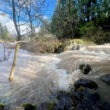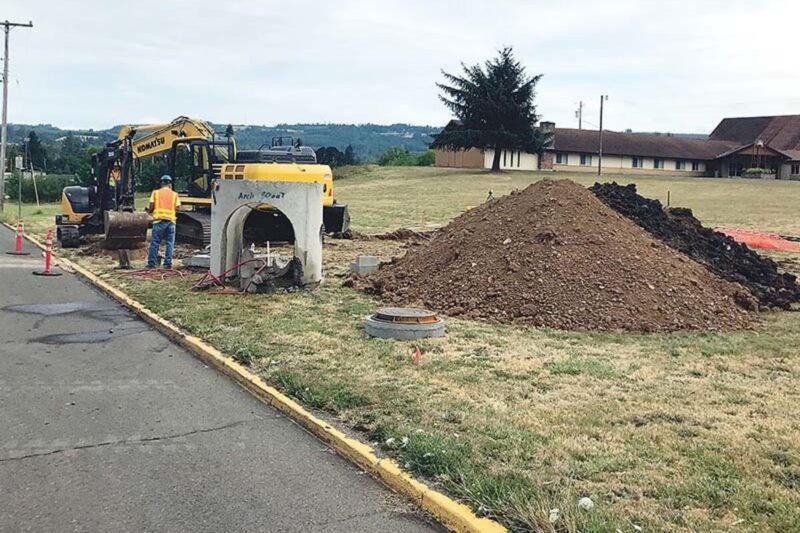Sean C. Morgan
Of The New Era
Sweet Home city councilors last week gave an informal nod to a change in water rates that will result in lower bills for most Sweet Home residents, while increasing bills for some residents and for businesses.
For residents using the average amount of water each month, approximately 600 cubic feet, the monthly water charge increases from $46.49 to $47.74. The entire utility bill increases by $1.25, from $117.70 to $118.95. The entire utility bill includes sewer charges, which are not increasing this year, and a storm water drainage utility charge of $1.
While the average amount of water used is 600 cubic feet per month, most residents use less. The median for water consumption is between 300 and 400 cubic feet per month. One hundred cubic feet is approximately 748 gallons.
City Finance Director Brandon Neish said that 71 percent of residents, those using 500 cubic feet or less per month, will see a decrease in water bills. Some 2,034 out of 2,884 residential customers use 500 cubic feet or less.
The first 300 cubic feet of water is included with the base charge. Those using 300 cubic feet or less will see their water charges decrease from $22.91 to $19.99. Their combined city utility bills, including sewer and storm drainage, will decrease from $64.78 to $61.86.
Those using 400 cubic feet will see total bills decrease from $82.42 to $80.89, and those using 500 cubic feet will see their bills decline from $100.06 to $99.92.
Those using 600 cubic feet and more will see increases in their bills. At 700 cubic feet, total monthly bills increase from $135.34 to $137.98. At 1,000 cubic feet, bills increase from $188.26 to $195.07.
In May, the city had one residential customer who used 2,600 cubic feet of water, the most of all residential customers. The bill for that customer will increase from $399.94 to $423.43 per month.
Under the new rate structure, the base charge for water service decreases from $22.91 to $19.99. The commodity charge, which is imposed after the first 300 cubic feet for each additional 100 cubic feet of water usage, increases from $7.86 to $9.25.
Commercial, industrial and bulk water customers do not receive the 300 cubic feet of water that residents do as part of the base charge. The commodity charge is imposed for each 100 cubic feet.
For three-quarter-inch commercial, industrial and bulk services, which is the same as most residential customers, the base charge decreases from $22.91 to $19.91. For commercial customers, the commodity charge increases from $7.78 to $9.22 per 100 cubic feet. For industrial and bulk customers, the commodity charge increases from $7.54 to $9.14 per 100 cubic feet.
At 600 cubic feet of use, commercial water bills will increase from $69.59 to $75.31. Some 166 out of 228 commercial customers in the city use 600 cubic feet or less.
For industrial and bulk customers, the bills increase from $68.15 to $74.83. The city has five three-quarter-inch connections among a total of 16 industrial and bulk customers. The remainder are on 1-inch to 3-inch connections.
The city projects $2.3 million in revenue from the new rates. It projects $2.5 million in water expenses in 2019-20. Neish said that existing reserves will cover the difference.
During a council work session on July 16, Neish said that not changing the rates would result in a loss of $120,000 in revenue budgeted for 2019-20.
The council could do that, he said, but “honestly that’s like kicking the can down the road.”
The water system would be in deficit by 2021, Neish said, and in a $92,000 hole in 2022.
Parts of the water distribution system are 80 years old, he noted. The lifespan of the pipes is 40 to 50 years, and that’s why the city has had to fix a significant number of pipes.
Public Works has identified some $7 million in projects to improve the system for the next five years, Neish said. The city has identified funding for the next two years. This year, it is setting aside $300,000 to evaluate the city’s water reservoirs, one of which was taken offline because it was leaking, and $50,000 to replace the sodium hypochlorite system in the Water Treatment Plant.
Next year, city officials want to spend $445,000 in line replacement projects on Nandina Street, Spruce Street and the south end of 9th Avenue and design work on the “northern transmission main,” which serves the east end of the city.
About 10 more projects are in the queue, but city officials have not identified funding yet.
Public Works Director Greg Springman said that a lot of the projects are the replacement of old 2-inch water lines, which have capacity problems.
Not raising rates means putting off some of this work, Neish said.
“As an organization, we have to make a decision how to move forward.”
Changing the rate will allow the city to stabilize the fund and do some projects, he said.
“The more we push these off, the longer this list gets.”
The city also needs to be able to take care of emergencies when they occur, which requires the city to maintain some reserves, he said.
“The problem with putting it off, it’ll just get worse and worse and worse,” said Councilor Dave Trask, and that will cause “one of these emergencies.”
With a couple of developments under construction, Mayor Greg Mahler asked whether staff members how they might want to change the city’s systems development charges.
City Manager Ray Towry said city officials will begin looking at Sweet Home’s systems development charges once the city has hired an engineer of record. The city’s total for systems development charges is nearly $2,000, which is much lower than other cities.
Systems development charges are imposed on developers as they construct new buildings. Funds can be used to pay for the impact of the new buildings on city infrastructure and increase capacity.
A major component of Sweet Home’s water bill is debt, some 22.6 percent, Towry said, but the city is “stuck” with the payment while the Water Treatment Plant is nearly 10 years old, which will require some maintenance and updating.
Other cities in the area or of similar size are carrying much less debt, Neish said. Among nine cities, only two spend more than 10 percent of their budgets on debt: Stayton, with 10.2 percent, and Albany, with 13.2 percent.
Neish said Sweet Home doesn’t have to have any options to refinance the debt, which was incurred in the construction of the Water Treatment Plant, which went online in 2010. The city is not scheduled to pay off that debt until 2034. The city borrowed nearly $12 million to construct the plant.
“We just need some direction,” Towry said. “If you’re saying we don’t want to raise rates, it gives us direction.”
Staff will respond with recommendations for adjusting the budget, he said.
“Even if it went up two bucks a month, they’re not going to be happy,” said Councilor Cortney Nash. “But how happy are they gong to be when the 2-inch water main breaks (and they have no water service)? These mains have to be fixed.”
Rate increases should have been incremental over time rather than large increases periodically, Mahler said.
“Maintenance is the thing that goes first, and now we’re paying the price,” Trask said.
“I’m for this,” Mahler said. “I think we need to get going.”
Councilor Susan Coleman said she wanted to know how the rate increase would impact commercial and bulk customers.
Neish said it would be approximately an 8.4-percent increase on average for bulk users, of which the city has three or four. Freezing the bulk rate, which increased by 45 percent last year, would reduce anticipated revenue by $18,500. Freezing the commercial rate would reduce anticipated revenue by some $61,000.
“I don’t think it’s that big a deal,” said Councilor James Goble. “it’s going up a couple bucks.”
Councilor Diane Gerson said she didn’t think the council had much choice.
She wasn’t concerned about the commercial rate, but she said the council should think about the bulk rate.
Brandy Jordan of No Drought Potable Water Service asked the council in June to return to the rates in effect before last year’s increase or a “flat rate for bulk water users.”
No Drought is concerned that it cannot afford to pay $10 per 100 cubic feet, she told the council.
Sweet Home School District officials complained earlier in the year about the 45-percent increase in the bulk water commodity charge.
“Our consumers are still stinging from the last increase,” said Councilor Lisa Gourley. She asked whether the council could soften the increase and what the downside would be returning to a structure that provides 400 cubic feet of water to residents at the base charge.
Neish said that would reduce projected revenue by $323,000.
Springman told the council that the work his Public Works crews are doing in the water system will impact rates.
It’ll take a year or two of work and leak repairs for the ship to turn on operations and maintenance where an impact can be seen on the rates, he said.
“Previous councils worked really hard to keep rates down in a tough economy,” Towry said. “It’s never pleasant to be in City Hall the month that water rates go up.”
But in general, he said, when city staff get questions from residents, they explain what’s going on, and “they get it.”
“This is not that big an increase, but it’s needed,” Goble said.
After the rate increase, rather than being “keyboard warriors,” Goble asked members of the public with questions and comments to attend a council meeting.
Trask said he doesn’t know where the city could cut, but he’s seeing a lot of work getting done.
“At some point, you’ve got to bite the bullet,” Trask said. “I think we should move forward.”
“I don’t think we have a choice,” Gerson said.
“I’m not for it, but I’ll accept it,” Gourley said.
Coleman echoed the thought.
Staff planned to return to the council during its regular meeting Tuesday, July 23, after The New Era press time.
The council held off on discussing a proposal to increase the storm drainage charge from $1 to $3 per month. A discussion will be scheduled on that topic later.





